Venice top tourist attractions city travel maps
Must-see places to visit detailed streets & districts travel plan - Venice top tourist attractions map

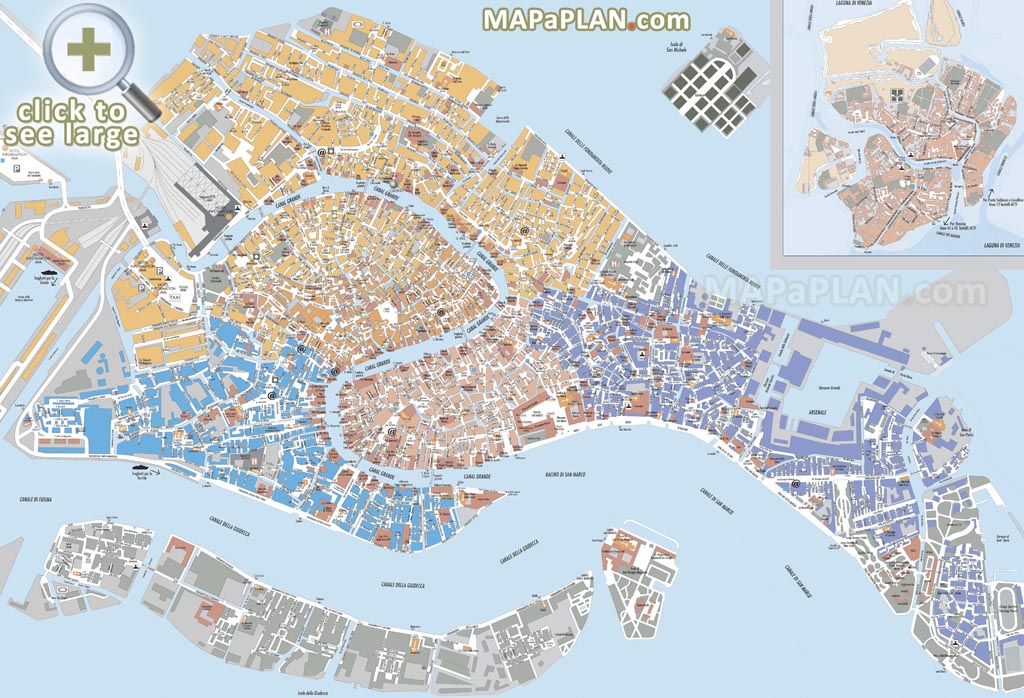
Maps of best attractions in Venice
The Venice maps will help you navigate this remarkable place. Discovering its unique character by wandering aimlessly around the city and getting yourself lost in the narrow streets and canals is definitely enjoyable. However if you have a tight schedule, it's worth having a set of maps showing the locations of the must-see tourist attractions. You can click the relevant plan and then save a high resolution version for offline access or printing. The maps show the top 10 landmarke and many more, including Grand Canal, St Mark’s Square, St Mark’s Basilica, Campanile (belltower), Torre dell’Orologio (clock tower), Museo Correr, Doge’s Palace, Bridge of Sighs (Ponte dei Sospiri), Gallerie dell’Accademia, Ca d’Oro palazzo, Murano glass-blowing workshops, Peggy Guggenheim Collection, I Frari, Palazzo Grassi and Punta della Dogana, La Biennale festival, Rialto Bridge, Gondola trips, Santa Maria della Salute, Teatro La Fenice, Chiesa di San Zaccaria, Vaporetto water buses, Lido island. This charming Italian city offers contless other wonders, such as little shops selling hand-made Carnival masks, beautiful glassware and lovely fabrics. With the help of our maps you will be able to have an unforgettable stay in this exceptional city.
Grand Canal main buildings bird's eye 3d aerial view - Venice top tourist attractions map
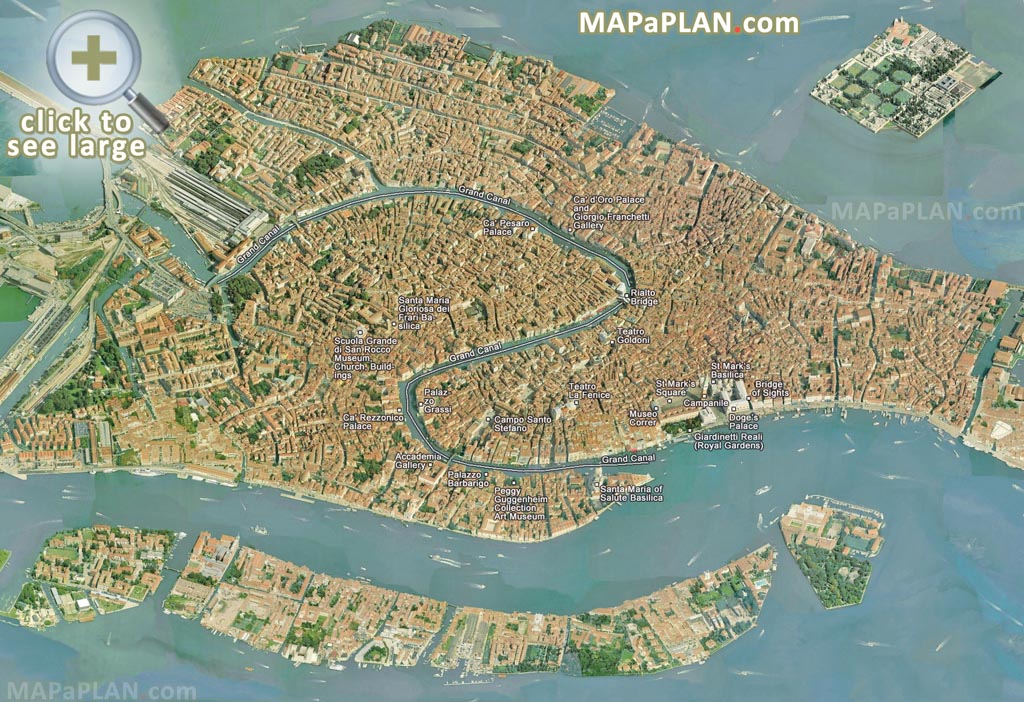
You can view, download or print a full, high resolution (detailed, large) version of this image by clicking on the plan itself
Water bus transit lines stations (Vaporetto) Actv public transport planner - Venice top tourist attractions map
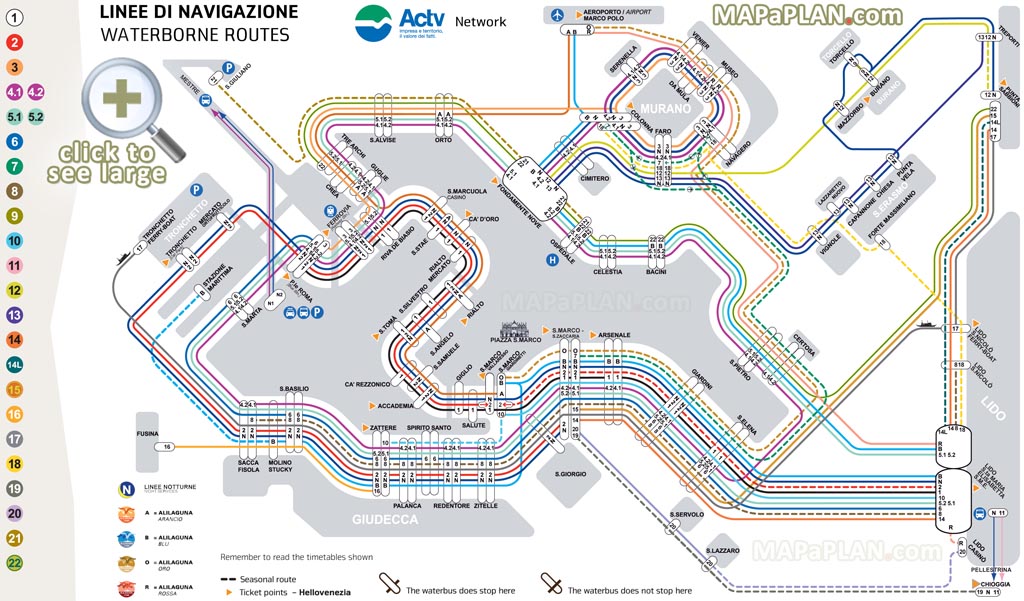
You can view, download or print a full, high resolution (detailed, large) version of this image by clicking on the plan itself
Murano island Glass Museum & churches location map - Venice top tourist attractions map
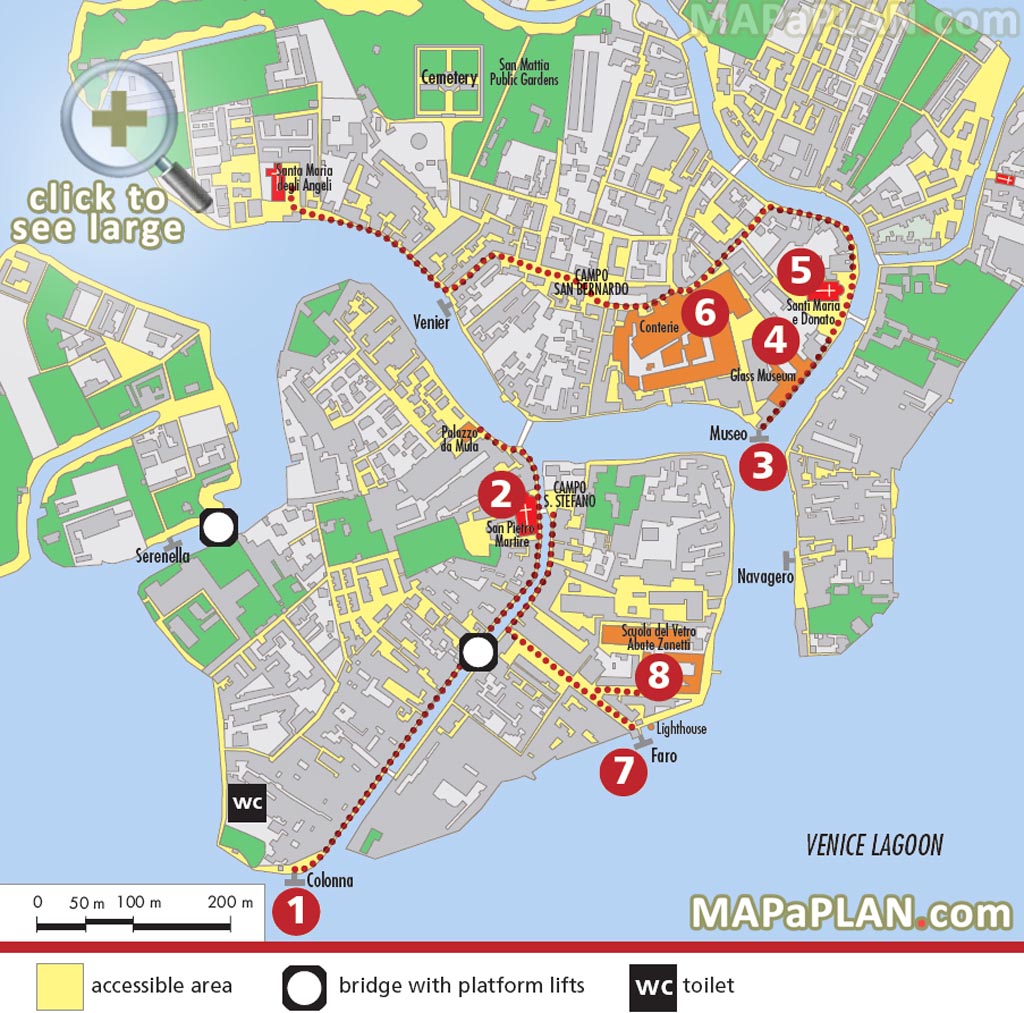
You can view, download or print a full, high resolution (detailed, large) version of this image by clicking on the plan itself
Marciana area with St Mark's Square (Piazza San Marco) & Palazzo Ducale - Venice top tourist attractions map
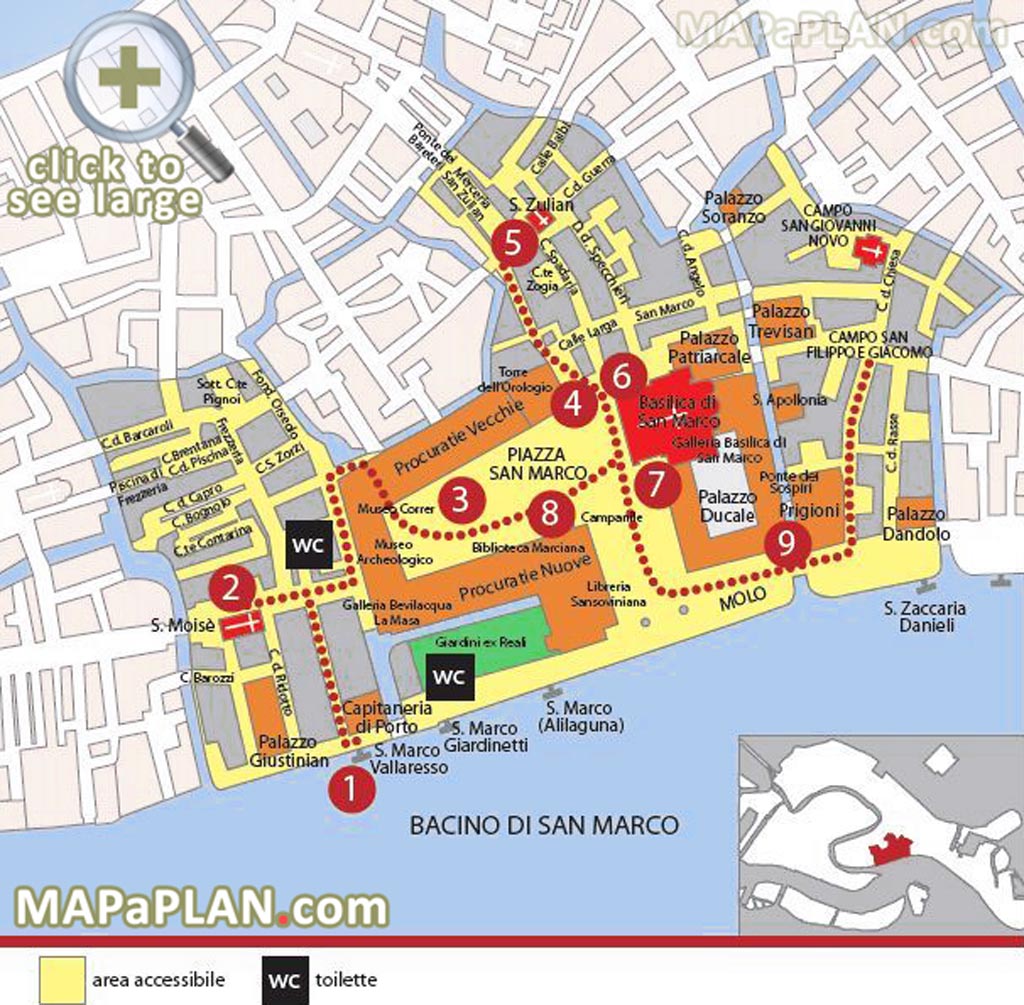
You can view, download or print a full, high resolution (detailed, large) version of this image by clicking on the plan itself
Explore Rialto Market major points of interest - Venice top tourist attractions map
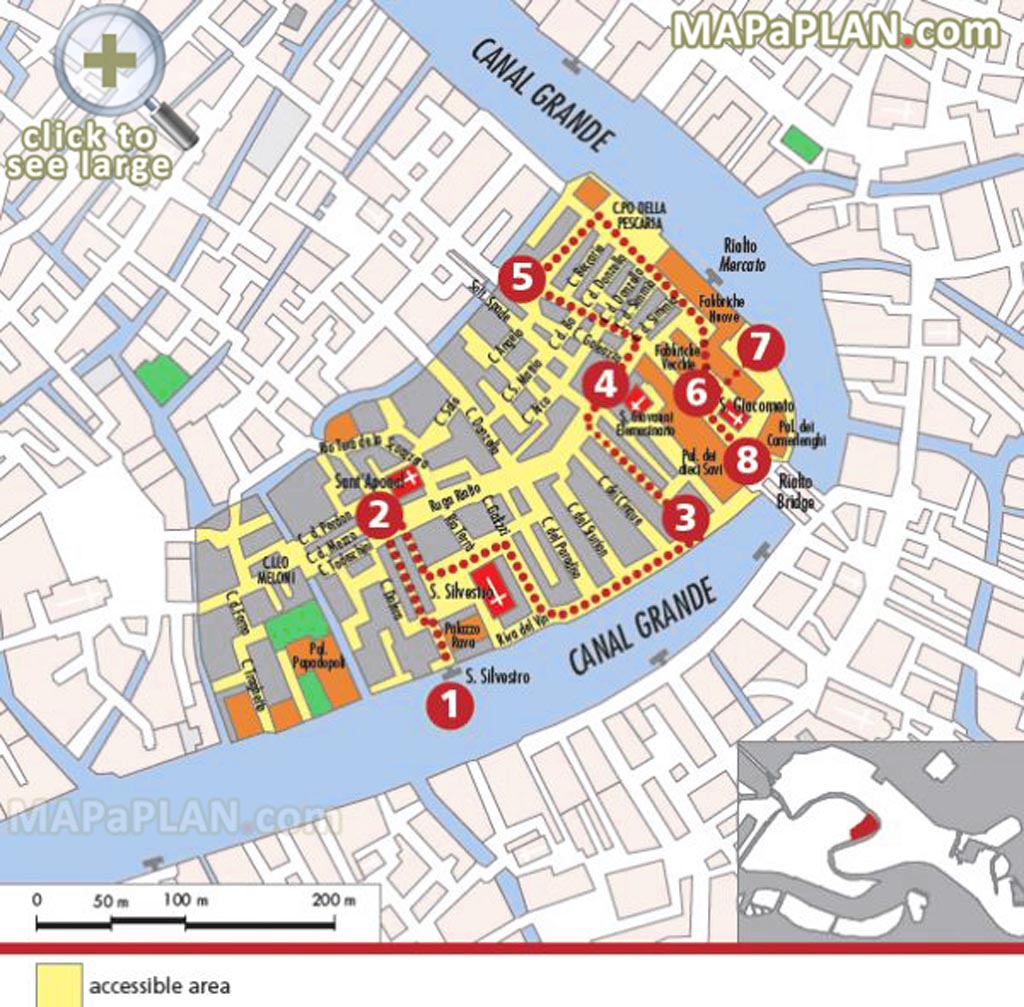
You can view, download or print a full, high resolution (detailed, large) version of this image by clicking on the plan itself
Rialto Bridge most famous landmarks sightseeing - Venice top tourist attractions map

You can view, download or print a full, high resolution (detailed, large) version of this image by clicking on the plan itself
Campo San Stefano favourite things to do walking route - Venice top tourist attractions map
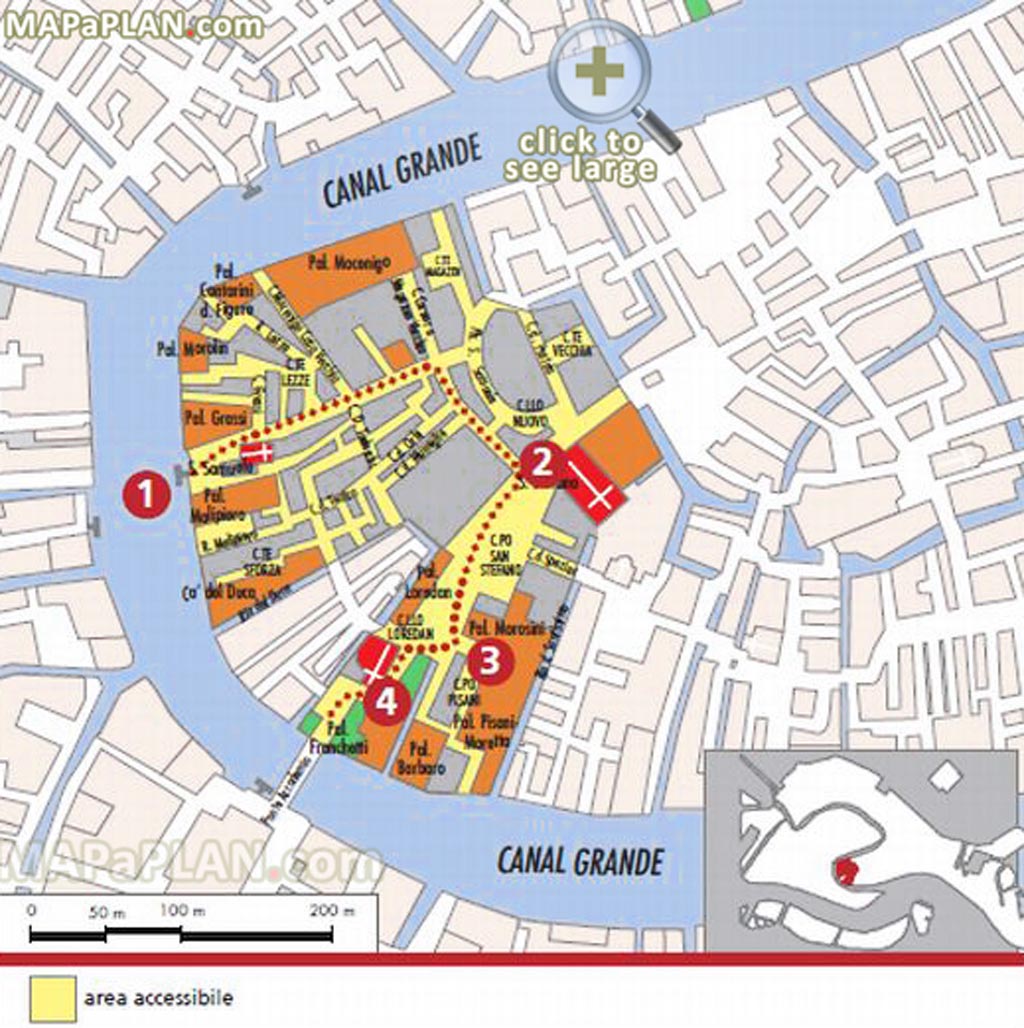
You can view, download or print a full, high resolution (detailed, large) version of this image by clicking on the plan itself
Campo Santo Margherita best destination spots - Venice top tourist attractions map
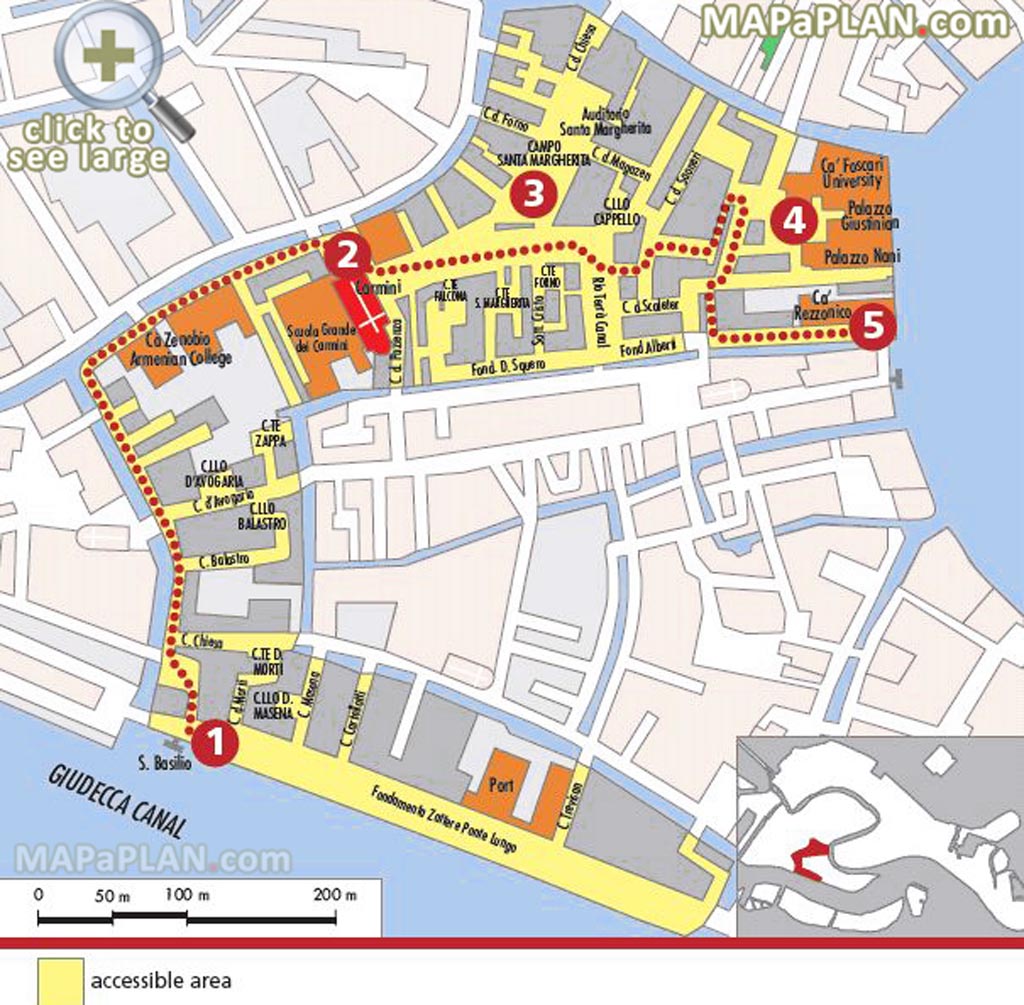
You can view, download or print a full, high resolution (detailed, large) version of this image by clicking on the plan itself
Basilica dei Frari & Scuola Grande di San Rocco guide - Venice top tourist attractions map
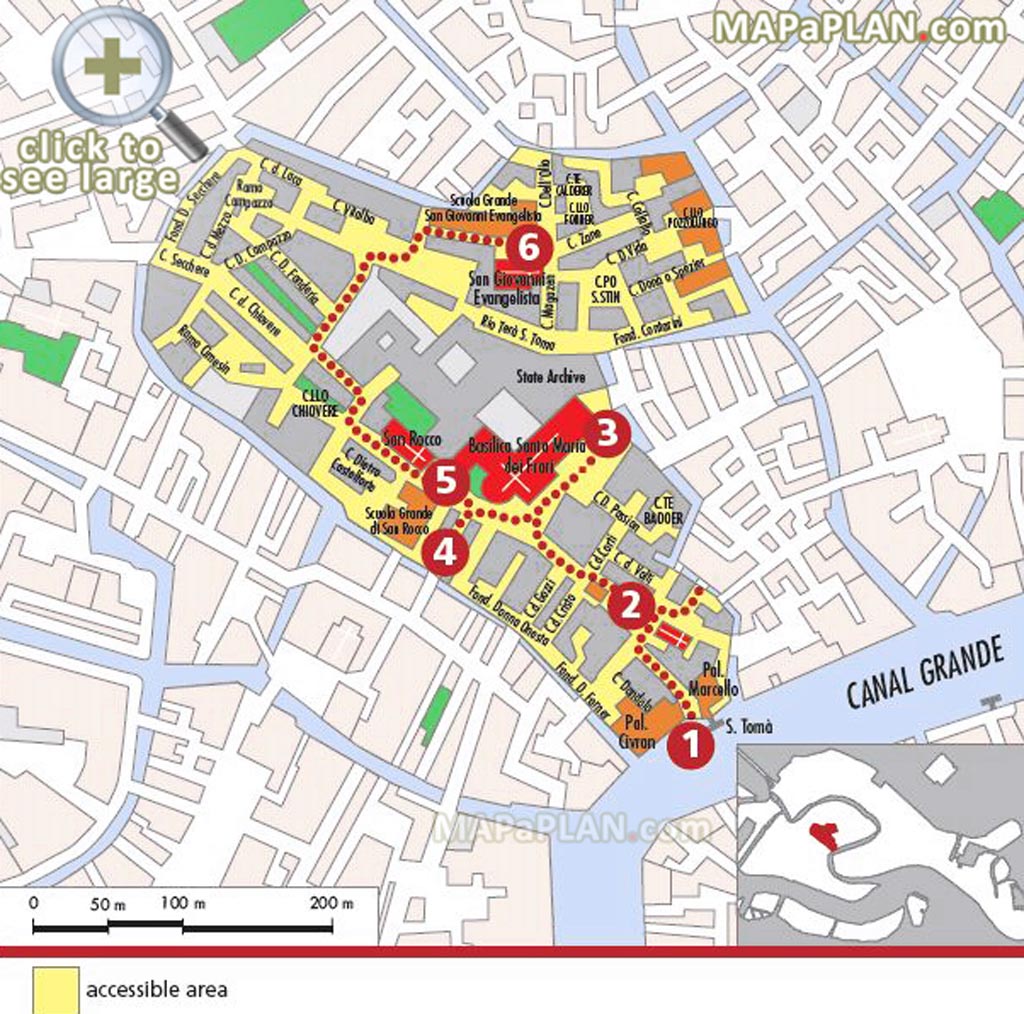
You can view, download or print a full, high resolution (detailed, large) version of this image by clicking on the plan itself
Burano island one day visitor trip itinerary - Venice top tourist attractions map
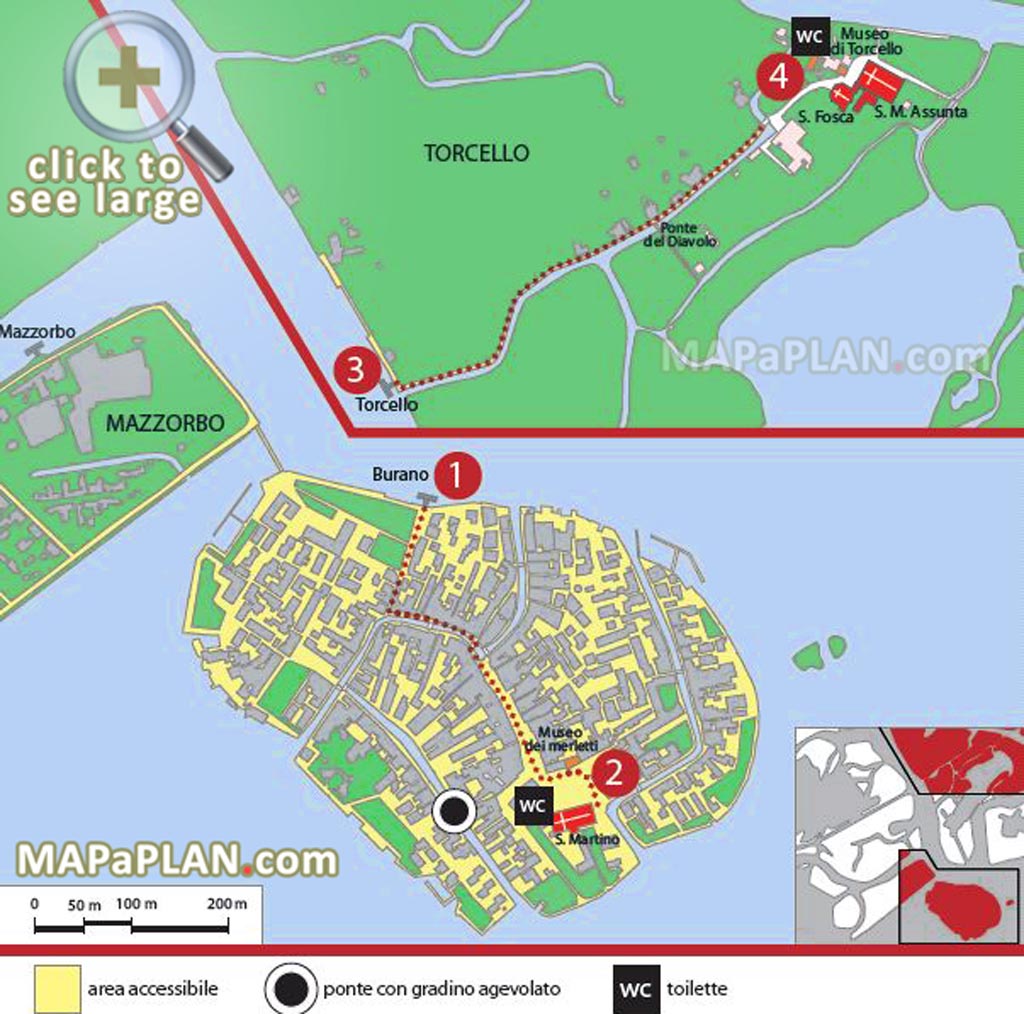
You can view, download or print a full, high resolution (detailed, large) version of this image by clicking on the plan itself
What to do and where to go in a week - Map showing Europe cruise ships terminal port - Venice top tourist attractions map
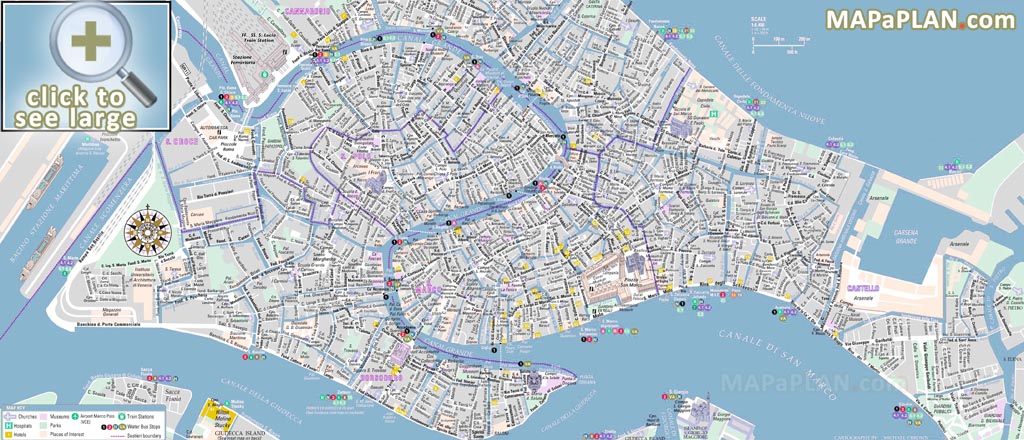
You can view, download or print a full, high resolution (detailed, large) version of this image by clicking on the plan itself
Gondola ferries (traghetto) & bridges on Grand Canal - Venice top tourist attractions map
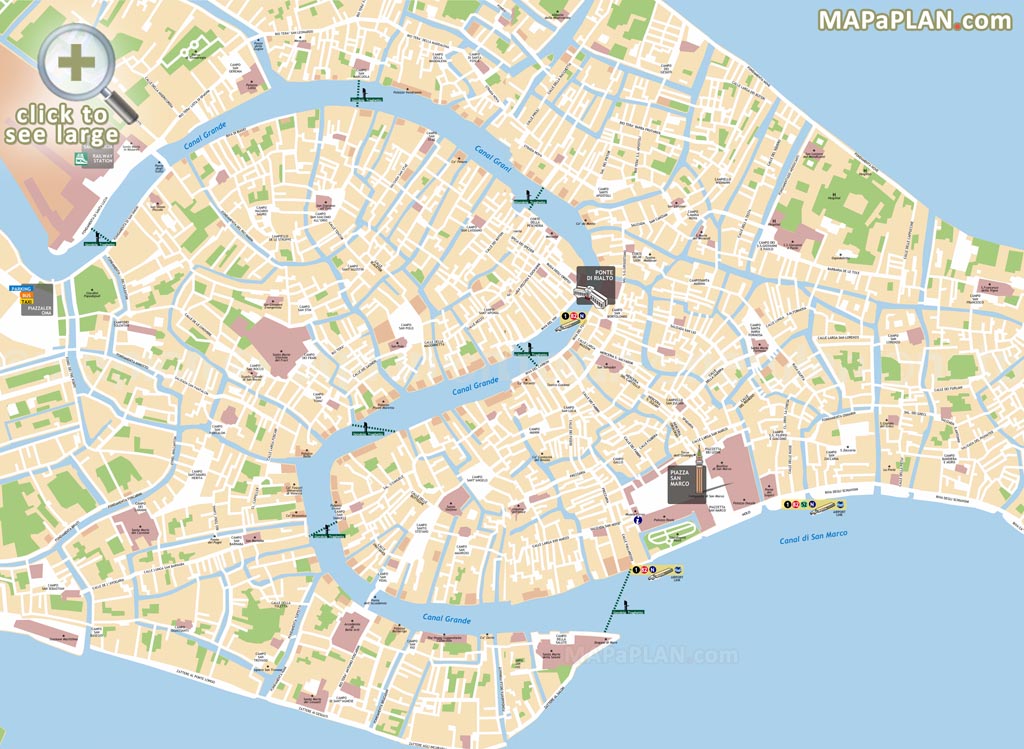
You can view, download or print a full, high resolution (detailed, large) version of this image by clicking on the plan itself
Must do in two days great places marked - Venice top tourist attractions map
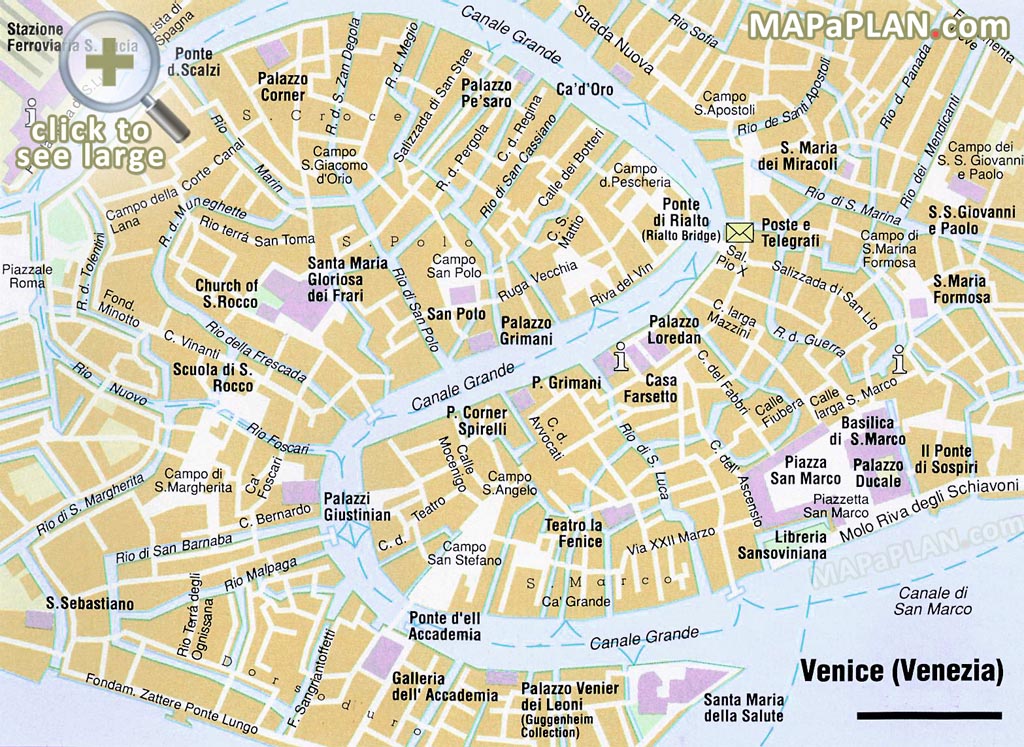
You can view, download or print a full, high resolution (detailed, large) version of this image by clicking on the plan itself
Central Venice most popular historical sights - Venice top tourist attractions map
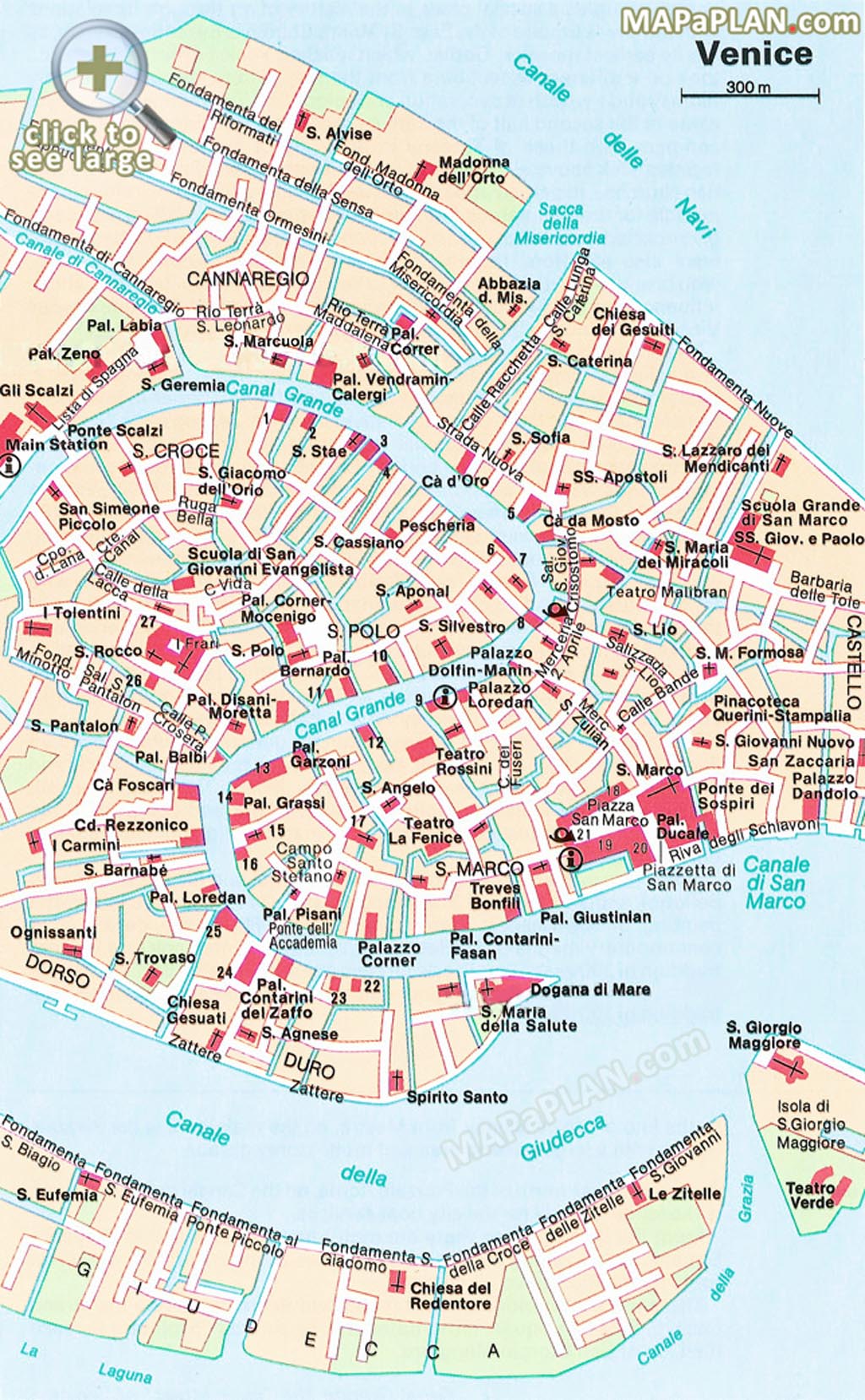
You can view, download or print a full, high resolution (detailed, large) version of this image by clicking on the plan itself
Venezia Santa Lucia train station & Vaporetto lines 1 & 2 routes with streets overlay - Venice top tourist attractions map
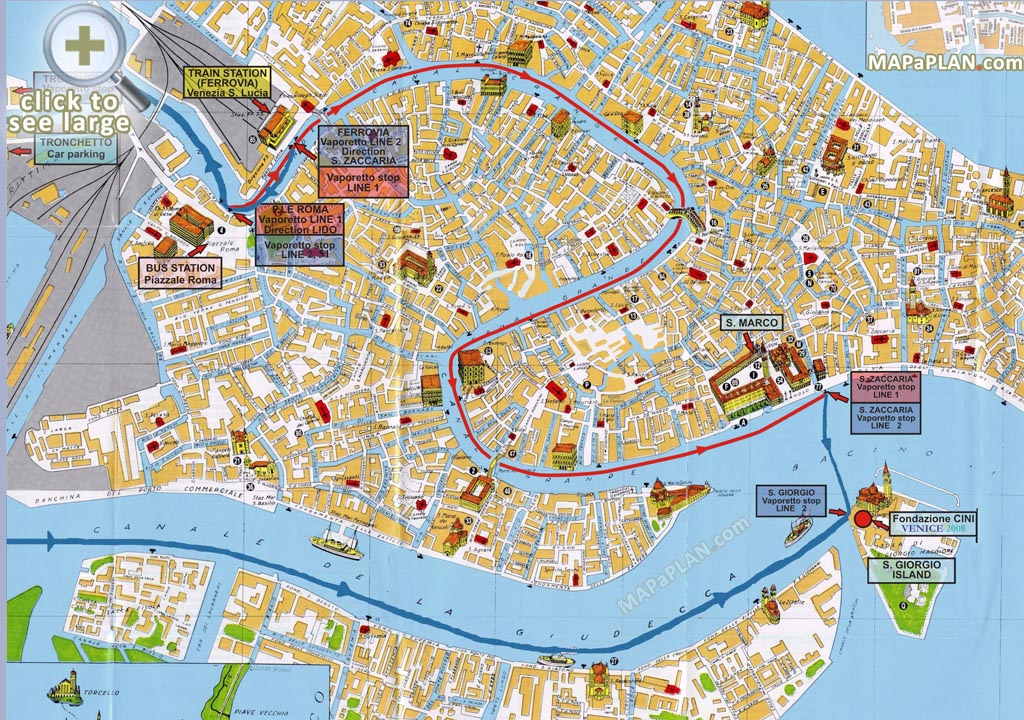
You can view, download or print a full, high resolution (detailed, large) version of this image by clicking on the plan itself
Interesting city highlights list & lagoon boat stops - Venice top tourist attractions map
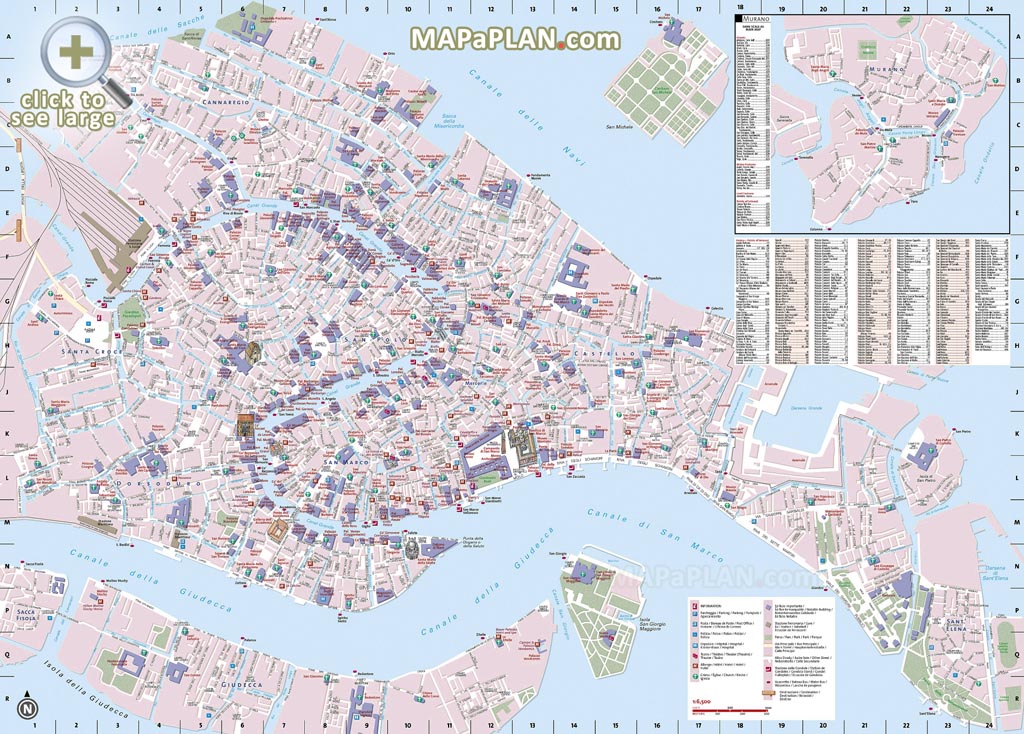
You can view, download or print a full, high resolution (detailed, large) version of this image by clicking on the plan itself
Map of top 10 attractions in Venice
The typical top ten attractions are listed below. You can find the detailed locations of these places on the maps above.
- St Mark's Square (Piazza San Marco)
- St. Mark's Basilica (Basilica di San Marco)
- Bridge of Sighs
- Doge's Palace
- St. Mark's Campanile bell tower (Campanile di San Marco)
- Grand Canal (Canal Grande)
- Rialto Bridge
- Gondola tour
- Ca' Rezzonico Palace and Museum
- Murano glass-blowing demonstration
What are some interesting facts about Venice?
The narrowest street in Venice is called Calletta or Ramo Varisco and it is located on a side street near Campo San Canciano: it is one of the narrowest streets in the world, because it measures only 53 cm. wide at chest level. The word Calle comes from the Latin language and it is the equivalent of street.
Venice has no sewer system, meaning its canals are also its sewer system. Household waste flows into the canals and is washed out into the sea twice a day with the tides.
Even though there are numerous campos (squares) in Venice, there is only one which is large enough to be called a piazza - San Marco Piazza (St Mark's Square).
Venice has over 450 palaces (palazzi) and important buildings built in a mixture of styles, Gothic, Byzantine, Baroque etc.
Acqua alta (meaning high water) happens when the tide is 3.54 inches above normal height.
Venice is divided into 6 districts called SESTIERI ( San Marco, Cannaregio, Santa Croce, Castello, San Polo, Dorsoduro) and the numbers of the houses are numbered according to the districts and not the street. It is almost impossible, however, to find an address if you do not know the way or, even better, the proximity to a certain monument, famous building or shop. In fact, even the postmen often use the street guide to find out where they should deliver the letters.
The earliest recorded use of gondolas in Venice dates to 1094.
There are over 400 pedestrian footbridges spanning about 150 canals.
Today, all gondolas are black—following a 16th-century decree to stop nobles from trying to outdo each other with ostentatious colors and ornamentation.
Venice is sinking at the rate of 1-2 millimeters a year.
Venice got its first female gondolier in 2010.
Today, 425 licensed gondoliers (and 175 substitutes) ply Venice's canals—down from a peak of more than 10,000 at the end of the 16th century.
Venice is made up of a collection of approx 115 tiny islands.
What are the the most romanting and unforgettable things to to in Venice?
Venice can sometimes become overwheling because of the number of tourists and attractions. Below is a list of things to do if you plan a trip off the beaten track.
- Go where the fancy takes you - wander aimlessly discovering little canals and quiet bridges.
- Get around in a gondola
- Take a tour of the Grand Canal in a regular Vaporetto (water bus)
- Experience (well-played) Vivaldi in Venice
- Cool down with a delicious gelato
What to see in Venice?
Venice is one of the symbols of Italy, a place considered by many unique and unrepeatable. Venice has always been a draw for rulers, artists, aristocrats and travelers. So let's consider what to see in Venice.
The city is situated on 117 islands and divided into six districts called sestiere. It is crossed by the Grand Canal (Canal Grande), which is also the main transportation artery. Venice is probably the only city in the world where there are no cars, buses or trams. Public transport is relies entirely on water buses called vaporetto.
Most tourists usually start their visit at St. Mark's Square. However it is often better to start exploring city by taking a vaporetto ride on the Grand Canal. This is the most effective way to see the beauty of Venice. During the ride, have a copy of the maps from this page and try to recognize the most important palaces (palazzo). You will pass see:
Academia Gallery (Gallerie dell'Academia) – it now houses an impressive collection of artworks dating from the fourteenth to the eighteenth century. Initially, it was the seat of the Academy of Painters and Sculptors, founded in 1750 by Gian Battista Piazzetta. After the fall of the Venetian Republic, the most valuable works of art were placed here. It was intended to be a training ground for young artists. In the early eighteenth century the collection was enriched by the works of art removed by Napoleon from the closed churches and monasteries. A public museum opened in 1817, and you can enjoy here works of Leonardo da Vinci, Titian, Andrea Mategny and Canaletto.
Golden House ( Ca 'd'Oro ) - the most beautiful palace on the Grand Canal, built in the Venetian Gothic style. The name comes from the golden decoration that once covered the façade. The building impresses with lightness and balancing proportions, although the main facade is asymmetrical. Inside there is the Galleria Giorgio Franchetti with a rich collection of medieval art.
Ca'Rezzonico - baroque palace, which now houses a museum depicting the life and art of eighteenth-century Venice; these times are often referred to as a time of fun, frivolity and decadence.
Church of Santa Maria Della Salute - one of the most emblematic places of the city, located at the mouth of the Grand Canal. It was built as a votive offering to the Virgin Mary for stopping the plague, which killed one third of the city population. The church is an example of the Venetian baroque. Every year, on November 21, a thanksgiving procession (Fest della Salute) passes along a special pontoon bridge from the other bank of the canal to the church.
Rialto Bridge (Ponte Rialto) - one of the most famous landmarks of Venice. It is also the oldest bridge in Venice. The first bridge was built here in the twelfth century (it was a pontoon bridge). In the fourteenth century it was replaced by a bridge made of wood. The current shape of Ponte Rialto has been designed by the architect Antonio da Ponte. Currently, the stone bridge provides a place for two rows of trade stalls and a pedestrian route in the middle and on the sides. You can buy typical Venetian souvenirs here, although their price at this point is quite high.
Palazzo Venier dei Leoni – hosts the Peggy Guggenheim Collection. She was an American in love with Venice. She purchased the pallazo in 1949 and gathered an impressive collection of modern art, including the works of Picasso, Salvador Dali, Max Ernst and Jackson Pollock.
St. Mark's Square - After enjoying the wonderful views of Canale Grande you will finally arrive at the St. Mark's Square - the heart and symbol of the city. St. Mark's Basilica is the most important building in the square. Mark became the patron saint of Venice in the ninth century. His relics were stolen from Alexandria and brought to the city by Venetian merchants. It was supposed to be a realization of the prophecy, Mark himself heard while travelling to Rome. As he was passing the Venice lagoon an angel appeared to him and said that is this is where his mortal remains will rest. The most characteristic feature of the main facade is the Loggia dei Cavalli , which contains a copy of the four horses brought from Constantinople.
Doge's Palace (Palazzo Ducale) – This is another important building in St. Mark's Square, the greatest masterpiece of Venetian Gothic style - sharp bends and openwork decoration give the impression of lightness and grace. For almost 1000 years the palace was the seat of doges (the rulers of Venice), the courts, the administration and the police. From the Renaissance courtyard the inside can be accessed by the so-called Golden Stairs.
Another place that you have to see is the Bridge of Sighs ( Ponte dei Sospiri), connecting the Doge's Palace with prison. Visible is the best from the waterfront of Pontedella Paglia.
St. Mark's Square is surrounded from both sides by the buildings of Old and New Procuracies, which are joined by the Napoleonic Wing. Procuracies were once the seat of the most important Venetian authorities. Between the Basilica and the Procuracies there Campanille , or bell tower, currently the tallest building in Venice, from which you can watch the city skyline. There is also a Clock Tower (Torre dell'Orologio), where the Latin inscription proclaims that the 'the clock measures only happy hours'.
What else to explore?
Just like Rome, Venice is a city of churches. Particularly worth visiting are
- San Zaccharia with the relics of St. Zechariah and precious Renaissance frescoes,
- Santa Maria dei Miracoli with the miraculous image of the Madonna,
- Zanipolo (Santi Giovanni e Paolo), and
- Santa Maria Gloriosa dei Frari with valuable paintings by Titian.
Gondola ride
No one can imagine Venice without a gondola. Gondola ride is a popular, but an expensive thing to do. By choosing a ride remember that the fee is charged per boat, not per person. The price can be negotiated, and it's worth asking for current prices at the tourist information point.
The three islands of Murano, Burano and Torcello
It is also worth visiting the three islands of the Venice lagoon: Murano, Burano and Torcello. Murano is the center of production of the famous Venetian glass. You can visit the museum and see a glass-making demonstration. Burano is famous for its beautiful, intricate lace, produced here since the fifteenth century. Today, most lace products is imported, but you can still meet woman churning them in traditional manual method. Torcello island is now completely deserted. Its biggest attraction is the church of Santa Maria Assunta di Torcello and Muzeo - a museum depicting the history of the lagoon.
How can I find specific tourist attractions on the map of Venice?
Our interactive city maps are easy to explore. You can pan, zoom in, and zoom out on the high-resolution map to locate major tourist attractions. Each map highlights key landmarks, making it simple to find the sights you're most interested in, whether it's a famous monument, museum, or other point of interest.
Can I get a visual representation of the area around Venice?
For some cities, we provide a general view of the area surrounding popular attractions. While this image won't show the exact street-level view, it helps you understand the layout of the neighborhood, showing how the landmarks are situated in relation to other points of interest around Venice.
Can I explore maps for both tourist attractions and other points of interest?
Yes! Our platform offers maps covering a range of highlights, from top tourist attractions to other noteworthy areas such as parks, restaurants, and entertainment venues. Whether you're planning a visit to a museum or looking for a nearby park, our detailed maps make it easy to find the best spots in the city.
Related keywords
2023, 2024, 2025, 2025, 2026, 2027, 2028, 2029, download, print, printable, free, detailed, aerial, bird's eye, guide, map, plan, planner, travel, sightseeing, visit, trip, tour, tourist, what to do, where to go, things to do, must see, top attractions, points of interest, places, sites, sights, buildings, spots, destinations, locations, landmark, museum, in a week, in 3 days, one day, city, route, metro, subway, underground, tube, bus, kids, chidren, top 10, top ten, popular, famous, interesting, highlights